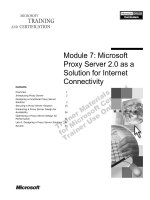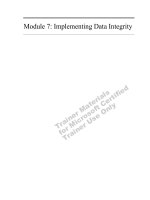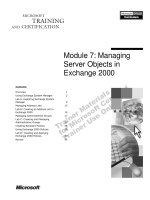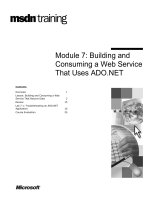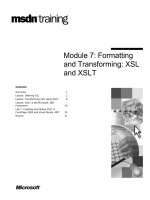CHFI module 7 :Network forensics
Bạn đang xem bản rút gọn của tài liệu. Xem và tải ngay bản đầy đủ của tài liệu tại đây (10.52 MB, 118 trang )
Network Forensics
Module 07
Computer Hacking Forensic Investigator
Network Forensics
Exam 312-49
Network Forensics
Module 07
Designed by Cyber Crime Investigators. Presented by Professionals.
Copyright © by EC-Council. All Rights Reserved. Reproduction is Strictly Prohibited.
Computer Hacking Forensic Investigator v9
Module 07: Network Forensics
Exam 312-49
Module 07 Page 793
Computer Hacking Forensic Investigator Copyright © by EC-Council
All Rights Reserved. Reproduction is Strictly Prohibited.
Computer Hacking Forensic Investigator
Network Forensics
Exam 312-49
Module Objectives
After successfully completing this module, you will be able to:
1
Understand the importance of network forensics
2
Discuss the fundamental logging concepts
3
Summarize the event correlation concepts
4
Understand network forensic readiness and list the network forensics steps
5
Examine the Router, Firewall, IDS, DHCP and ODBC logs
6
Examine the network traffic
7
Document the evidence gathered on a network
8
Perform evidence reconstruction for investigation
Copyright © by EC-Council. All Rights Reserved. Reproduction is Strictly Prohibited.
Network forensics ensures that all the network data flows are instantly visible, enabling
monitors to notice insider misuse and advanced threats. This module discusses the importance
of network forensics, the analysis of logs from various devices, and investigating network traffic.
Network forensics includes seizure and analysis of network events to identify the source of
security attacks or other problem incidents by investigating log files.
Module 07 Page 794
Computer Hacking Forensic Investigator Copyright © by EC-Council
All Rights Reserved. Reproduction is Strictly Prohibited.
Computer Hacking Forensic Investigator
Network Forensics
Exam 312-49
Scenario
Jessica was missing from her home for a week. She left a note
for her father mentioning that she was going to meet her school
friend. A few weeks later Jessica’s dead body was found near a
dumping yard.
Investigators were called in to investigate Jessica’s death. A
preliminary investigation of Jessica’s computer and logs revealed
some facts that helped the cops trace the killer.
Copyright © by EC-Council. All Rights Reserved. Reproduction is Strictly Prohibited.
Module 07 Page 795
Computer Hacking Forensic Investigator Copyright © by EC-Council
All Rights Reserved. Reproduction is Strictly Prohibited.
Computer Hacking Forensic Investigator
Network Forensics
Exam 312-49
Network Forensics
Network forensics is the capturing, recording, and analysis of network event in order to discover the
source of security incidents
Capturing network traffic over a network is simple in theory, but relatively complex in practice; because of
the large amount of data that flows through a network and the complex nature of the Internet protocols
Recording network traffic involves a lot of resources, which makes it unfeasible to record all the data
flowing through the network
Further, an investigator needs to back up these recorded data to free up recording media and preserve the
data for future analysis
Network forensics can reveal the following information:
Source of security incidents
The path of intrusion
The Intrusion techniques an attacker used
Traces and evidence
Copyright © by EC-Council. All Rights Reserved. Reproduction is Strictly Prohibited.
Network forensics is the implementation of sniffing, recording, acquisition, and analysis of
network traffic and event logs to investigate a network security incident. Capturing network
traffic over a network is simple in theory, but relatively complex in practice due to many
inherent reasons such as the large amount of data flow and complex nature of Internet
protocols. Recording network traffic involves a lot of resources. It is often not possible to record
all the data flowing through the network due to the large volume. Again, these recorded data
need to be backed up to free recording media and for future analysis.
The analysis of recorded data is the most critical and time-consuming task. There are many
automated analysis tools for forensic purposes, but they are insufficient, as there is no
foolproof method to recognize bogus traffic generated by an attacker from a pool of genuine
traffic. Human judgment is also critical because with automated traffic analysis tools, there is
always a chance of false positives.
Network forensics is necessary in order to determine the type of attack over a network and to
trace the culprit. A proper investigation process is required to produce the evidence recovered
during the investigation in the court of law.
Module 07 Page 796
Computer Hacking Forensic Investigator Copyright © by EC-Council
All Rights Reserved. Reproduction is Strictly Prohibited.
Computer Hacking Forensic Investigator
Network Forensics
Exam 312-49
Postmortem and Real-Time
Analysis
Forensic examination of logs is divided into two categories :
Postmortem
Postmortem of logs is done
for the investigation of
something that has already
happened
Forensic
Examination
of Logs
Real-Time Analysis
Real-Time analysis is
done for the ongoing
process
Note: Practically, IDS is the real-time analysis, whereas the forensic examination is postmortem
Copyright © by EC-Council. All Rights Reserved. Reproduction is Strictly Prohibited.
Forensic examination of logs has two categories:
Postmortem
Investigators perform postmortem of logs to detect something that has already occurred in a
network/device and determine what it is.
Here, an investigator can go through the log files a number of times to examine and check the
flow of previous runs. When compared to real-time analysis, it is an exhaustive process, since
the investigators need to examine the attack in detail and give a final report.
Real-Time Analysis
Real-time analysis is an ongoing process, which returns results simultaneously, so that the
system or operators can respond to the attacks immediately.
Real-time analysis is an analysis done for the ongoing process. This analysis will be more
effective if the investigators/administrators detect the attack quickly. In this analysis, the
investigator can go through the log files only once to evaluate the attack, unlike postmortem
analysis.
Module 07 Page 797
Computer Hacking Forensic Investigator Copyright © by EC-Council
All Rights Reserved. Reproduction is Strictly Prohibited.
Computer Hacking Forensic Investigator
Network Forensics
Exam 312-49
Network Vulnerabilities
Network Vulnerabilities
Internal
Network Vulnerabilities
These vulnerabilities occur
due to the overextension of
bandwidth and bottlenecks
External
Network Vulnerabilities
These vulnerabilities occur
due to the threats such as
DoS/DDoS attacks and
network data interception
Copyright © by EC-Council. All Rights Reserved. Reproduction is Strictly Prohibited.
Network Vulnerabilities
The massive technological advances in networking have also led to a rapid increase in the
complexity and vulnerabilities of networks. The only thing that a user can do is minimize these
vulnerabilities, since the complete removal of the vulnerabilities is not possible. There are
various internal and external factors that make a network vulnerable.
Internal network vulnerabilities
Internal network vulnerabilities occur due to the overextension of bandwidth and bottlenecks.
Overextension of bandwidth: Overextension of bandwidth occurs when user need
exceeds total resources.
Bottlenecks: Bottlenecks usually occur when user need exceeds resources in particular
network sectors.
The network management systems direct these problems and software to the log or other
management solutions. System administrators examine these systems and identify the location
of network slowdowns. Using this information, they reroute the traffic within the network
architecture to increase the speed and functionality of the network.
External network vulnerabilities
External network vulnerabilities occur due to threats such as DoS/DDoS attacks and network
data interception.
Module 07 Page 798
Computer Hacking Forensic Investigator Copyright © by EC-Council
All Rights Reserved. Reproduction is Strictly Prohibited.
Computer Hacking Forensic Investigator
Network Forensics
Exam 312-49
DoS and DDoS attacks result from one or numerous attacks. These attacks are responsible for
slowing down or disabling the network and are considered as one of the most serious threats
that a network faces. To minimize this attack, use network performance monitoring tools that
alert the user or the administrator about an attack.
Data interception is a common vulnerability among LANs and WLANs. In this type of attack, an
attacker infiltrates a secure session and thus monitors or edits the network data to access or
edit the network operation. In order to minimize these attacks, the user or administrator needs
to apply user authentication systems and firewalls to restrict unauthorized users from accessing
the network.
Module 07 Page 799
Computer Hacking Forensic Investigator Copyright © by EC-Council
All Rights Reserved. Reproduction is Strictly Prohibited.
Computer Hacking Forensic Investigator
Network Forensics
Exam 312-49
Network Attacks
Most common attacks launched
against networks:
Attacks specific to wireless
networks:
Eavesdropping
Rogue Access Point Attack
Data Modification
Client Mis-association
IP Address Spoofing
Misconfigured Access Point Attack
Denial of Service Attack
Unauthorized Association
Man-in-the-Middle Attack
Ad Hoc Connection Attack
Packet Sniffing
HoneySpot Access Point Attack
Enumeration
AP MAC Spoofing
Session Hijacking
Jamming Signal Attack
Buffer Overflow
Email Infection
Malware attacks
Password-based attacks
Router Attacks
Copyright © by EC-Council. All Rights Reserved. Reproduction is Strictly Prohibited.
Most common attacks against networks:
Eavesdropping
Eavesdropping is a technique used in intercepting the unsecured connections in order to steal
personal information, which is illegal.
Data Modification
Once the intruder gets access to sensitive information, his or her first step is to alter the data.
This problem is referred to as a data modification attack.
IP Address Spoofing
IP spoofing is a technique used to gain unauthorized access to a computer. Here, the attacker
sends messages to the computer with an IP address that indicates the messages are coming
from a trusted host.
Denial of Service (DoS)
In a DoS attack, the attacker floods the target with huge amount of invalid traffic, thereby
leading to exhaustion of the resources available on the target. The target then stops responding
to further incoming requests, thereby leading to denial of service to the legitimate users.
Module 07 Page 800
Computer Hacking Forensic Investigator Copyright © by EC-Council
All Rights Reserved. Reproduction is Strictly Prohibited.
Computer Hacking Forensic Investigator
Network Forensics
Exam 312-49
Man-in-the-Middle Attack
In man-in-the-middle attacks, the attacker makes independent connections with the
users/victims and relays messages between them, making them believe that their conversation
is direct.
Packet Sniffing
Sniffing refers to the process of capturing traffic flowing through a network, with the aim of
gaining sensitive information such as usernames and passwords and using them for illegitimate
purposes. In the computer network, packet sniffer captures the network packets. Software
tools known as Cain&Able are used to server this purpose.
Enumeration
Enumeration is the process of gathering information about a network that may help in an
attacking the network. Attackers usually perform enumeration over the Internet. During
enumeration, the following information is collected:
Topology of the network
List of live hosts
Architecture and the kind of traffic (for example, TCP, UDP, IPX)
Potential vulnerabilities in host systems
Session Hijacking
A session hijacking attack refers to the exploitation of a session-token generation mechanism or
token security controls, such that the attacker can establish an unauthorized connection with a
target server.
Buffer Overflow
Buffers have data storage capacity. If the data count exceeds the original capacity of a buffer,
then buffer overflow occurs. To maintain finite data, it is necessary to develop buffers that can
direct additional information when they need. The extra information may overflow into
neighboring buffers, destroying or overwriting the legal data.
Email Infection
This attack uses emails as a means to attack a network. Email spamming and other means are
used to flood a network and cause a DoS attack.
Malware Attacks
Malware is a kind of malicious code or software designed to damage the system. Attackers try
to install the malware on the targeted system; once the user installs it, it damages the system.
Password-based attacks
Password-based attack is a process where the attacker performs numerous login attempts on a
system or an application to duplicate the valid login and gain access to it.
Router attacks
It is the process of an attacker attempting to compromise the router and gaining access to it.
Module 07 Page 801
Computer Hacking Forensic Investigator Copyright © by EC-Council
All Rights Reserved. Reproduction is Strictly Prohibited.
Computer Hacking Forensic Investigator
Network Forensics
Exam 312-49
Attacks specific to wireless networks:
Rogue Access Point Attack
Attackers or insiders create a backdoor into a trusted network by installing an unsecured access
point inside a firewall. They then use any software or hardware access point to perform this
kind of attack.
Client Mis-association
The client may connect or associate with an AP outside the legitimate network either
intentionally or accidentally. An attacker who can connect to that network intentionally and
proceed with malicious activities can misuse this situation. This kind of client mis-association
can lead to access control attacks.
Misconfigured Access Point Attack
This attack occurs due to the misconfiguration of the wireless access point. This is the easiest
vulnerability the attacker can exploit. Upon successful exploitation, the entire network could be
open to vulnerabilities and attacks. One of the means of causing the misconfiguration is to
apply default usernames and passwords to use the access point.
Unauthorized Association
In this attack, the attacker takes advantage of soft access points, which are WLAN radios
present in some laptops. The attacker can activate these access points in the victim’s system
through a malicious program and gain access to the network.
Ad Hoc Connection Attack
In an Ad Hoc connection attack, the attacker carries out the attack using an USB adapter or
wireless card. In this method, the host connects with an unsecured station to attack a particular
station or evade access point security.
HoneySpot Access Point Attack
If multiple WLANs co-exist in the same area, a user can connect to any available network. This
kind of multiple WLAN is highly vulnerable to attacks. Normally, when a wireless client switches
on, it probes nearby wireless networks for a specific SSID. An attacker takes advantage of this
behavior of wireless clients by setting up an unauthorized wireless network using a rogue AP.
This AP has high-power (high gain) antennas and uses the same SSID of the target network.
Users who regularly connect to multiple WLANs may connect to the rogue AP. These Aps
mounted by the attacker are “honeypot” APs. They transmit a stronger beacon signal than the
legitimate APs. NICs searching for the strongest available signal may connect to the rogue AP. If
an authorized user connects to a honeypot AP, it creates a security vulnerability and reveals
sensitive user information such as identity, user name, and password to the attacker.
AP MAC Spoofing
Using the MAC spoofing technique, the attacker can reconfigure the MAC address in such a way
that it appears as an authorized access point to a host on a trusted network. The tools for
carrying out this kind of attack are changemac.sh, SMAC, and Wicontrol.
Module 07 Page 802
Computer Hacking Forensic Investigator Copyright © by EC-Council
All Rights Reserved. Reproduction is Strictly Prohibited.
Computer Hacking Forensic Investigator
Network Forensics
Exam 312-49
Jamming Signal Attack
In this attack, the attacker jams the WiFi signals to stop the all the legitimate traffic from using
the access point. The attacker blocks the signals by sending huge amounts of illegitimate traffic
to the access point by using certain tools
Module 07 Page 803
Computer Hacking Forensic Investigator Copyright © by EC-Council
All Rights Reserved. Reproduction is Strictly Prohibited.
Computer Hacking Forensic Investigator
Network Forensics
Exam 312-49
Where to Look for Evidence
Logs collected in the network devices and applications can be used as evidence for investigating
network security incidents
Functions
Handles high-level protocols,
issues of representation,
encoding, and dialog control
Provides a logical connection
between the endpoints and
provides transport
Selects the best path through
the network for data flow
Defines how to transmit an IP
datagram to the other devices
Layers
Application layer
Transport layer
Internet layer
Network Access layer
Protocols
Network Devices
and Applications
File Transfer (TFTP, FTP, NFS),
Email (SMTP), Network
Management (SNMP), Name
Management (DNS)
Servers/Desktops, Anti-virus,
Business Applications,
Databases
Transmission Control Protocol
(TCP) and User Datagram
Protocol (UDP)
Firewall, IDS/IPS
Internet Protocol (IP), Internet
Control Message Protocol
(ICMP), Address Resolution
Protocol (ARP)
Firewall, IDS/IPS, VPN
Ethernet, Fast Ethernet, SLIP,
PPP, FDDI, ATM, Frame Relay,
SMDS, ARP, Proxy ARP, RARP
Routers and Switches
Copyright © by EC-Council. All Rights Reserved. Reproduction is Strictly Prohibited.
Logs contain events associated with all the activities performed on a system or a network.
Hence, analyzing these logs help investigators trace back the events that have occurred. Logs
collected in the network devices and applications serve as evidence for investigators to
investigate network security incidents. Therefore, investigators need to have knowledge on
network fundamentals, TCP/IP model, and the layers in the model.
Transmission Control Protocol/Internet Protocol (TCP/IP) is a communication protocol used to
connect different hosts in the Internet. Every system that sends and receives information has a
TCP/IP program, and the TCP/IP program has two layers:
Higher Layer: It manages the information sent and received in the form of small data
packets sent over Internet and joins all those packets as a main message.
Lower Layer: It handles the address of every packet so that they all reach the right
destination.
Module 07 Page 804
Computer Hacking Forensic Investigator Copyright © by EC-Council
All Rights Reserved. Reproduction is Strictly Prohibited.
Computer Hacking Forensic Investigator
Network Forensics
Exam 312-49
FIGURE 7.1: OSI Model
The OSI 7 Layer model and TCP/IP 4 Layer model are as shown below:
FIGURE 7.2: OSI Model vs. TCP/IP Model
Module 07 Page 805
Computer Hacking Forensic Investigator Copyright © by EC-Council
All Rights Reserved. Reproduction is Strictly Prohibited.
Computer Hacking Forensic Investigator
Network Forensics
Exam 312-49
The TCP/IP model and OSI seven-layer models are similar in appearance. As shown in the above
figure, the Data Link Layer and Physical Layer of OSI model together form Network Access Layer
in TCP/IP model. The Application Layer, Presentation Layer, and Session Layer together form
the Application Layer in the TCP/IP Model.
Layer 1: Network Access Layer
This is the lowest layer in the TCP/IP model. This layer defines how to use the network to
transfer data. It includes protocols such as Frame Relay, SMDS, Fast Ethernet, SLIP, PPP, FDDI,
ATM, Ethernet, ARP, etc., which help the machine deliver the desired data to other hosts in the
same network.
Layer 2: Internet Layer
This is the layer above Network Access Layer. It handles the movement of data packet over a
network, from source to destination. This layer contains protocols such as Internet Protocol
(IP), Internet Control Message Protocol (ICMP), Address Resolution Protocol (ARP), Internet
Group Management Protocol (IGMP), etc. The Internet Protocol (IP) is the main protocol used
in this layer.
Layer 3: Transport Layer
Transport Layer is the layer above the Internet Layer. It serves as the backbone for data flow
between two devices in a network. The transport layer allows peer entities on the source and
destination devices to carry on a communication. This layer uses many protocols, among which
Transmission Control Protocol (TCP) and User Datagram Protocol (UDP) are the most widely
used.
TCP is preferable in case of reliable connections, while UDP can handle non-reliable
connections.
Layer 4: Application Layer
This is the topmost layer of the TCP/IP protocol suite. This layer includes all processes that use
the Transport Layer protocols, especially TCP and UDP, to deliver data. This layer contains many
protocols, with HTTP, Telnet, FTP, SMTP, NFS, TFTP, SNMP, and DNS being the most widely used
ones.
Module 07 Page 806
Computer Hacking Forensic Investigator Copyright © by EC-Council
All Rights Reserved. Reproduction is Strictly Prohibited.
Computer Hacking Forensic Investigator
Network Forensics
Exam 312-49
Log Files as Evidence
Log files are the primary records of user’s activity on a system or a network
Investigators use these logs to recover any services altered and discover the source of
illicit activities
The basic problem with logs is that they can be altered easily. An attacker can easily
insert false entries into log files
Computer records are not normally admissible as evidence; they must meet certain
criteria to be admitted at all
The prosecution must present appropriate testimony to show that logs are accurate,
reliable, and fully intact
Copyright © by EC-Council. All Rights Reserved. Reproduction is Strictly Prohibited.
In network forensic investigation, information log files help the investigators lead to the
perpetrator. Log files contain valuable data about all the activities performed on the system.
Different sources on a network/device produce their respective log files. These sources may be
operating systems, IDS, firewall, etc. Comparing and relating the log events help the
investigators deduce how the intrusion occurred. The log files collected as evidence need to
comply with certain laws to be acceptable in the court; additionally, an expert testimony is
required to prove that the log collection and maintenance occurred in the admissible manner.
Module 07 Page 807
Computer Hacking Forensic Investigator Copyright © by EC-Council
All Rights Reserved. Reproduction is Strictly Prohibited.
Computer Hacking Forensic Investigator
Network Forensics
Exam 312-49
Laws and Regulations
The following regulations, standards, and guidelines define organizations’ needs
for log management:
Federal Information
Security
Management Act
of 2002 (FISMA)
Sarbanes-Oxley
Act (SOX) of
2002
Gramm-LeachBliley Act
(GLBA)
Health Insurance
Portability and
Accountability Act
of 1996 (HIPAA)
Payment Card
Industry Data
Security
Standard
(PCI DSS)
Copyright © by EC-Council. All Rights Reserved. Reproduction is Strictly Prohibited.
Source:
Federal Information Security Management Act of 2002 (FISMA):
FISMA is the Federal Information Security Management Act of 2002 that states several key
security standards and guidelines, as required by Congressional legislation.
FISMA emphasizes the need for each Federal agency to develop, document, and implement an
organization-wide program to provide information security for the information systems that
support its operations and assets. NIST SP 800-53, Recommended Security Controls for Federal
Information Systems, was developed in support of FISMA. 11 NIST SP 800-53 is the primary
source of recommended security controls for Federal agencies. It describes several controls
related to log management, including the generation, review, protection, and retention of audit
records, as well as the actions to be taken because of audit failure.
Gramm-Leach-Bliley Act (GLBA): The Gramm-Leach-Bliley Act requires financial institutions—
companies that offer consumers financial products or services such as loans, financial or
investment advice, or insurance—to protect their customers’ information against security
threats. Log management can be useful in identifying possible security violations and resolving
them effectively.
Health Insurance Portability and Accountability Act of 1996 (HIPAA): The Health Insurance
Portability and Accountability Act of 1996 (HIPAA) includes security standards health
information. NIST SP 800-66, An Introductory Resource Guide for Implementing the Health
Insurance Portability and Accountability Act (HIPAA) Security Rule, lists HIPAA-related log
Module 07 Page 808
Computer Hacking Forensic Investigator Copyright © by EC-Council
All Rights Reserved. Reproduction is Strictly Prohibited.
Computer Hacking Forensic Investigator
Network Forensics
Exam 312-49
management needs. For example, NIST SP 800-66 describes the need to perform regular
reviews of audit logs and access reports. Additionally, it specifies that documentation of actions
and activities need to be retained for at least six years.
Sarbanes-Oxley Act (SOX) of 2002: The Sarbanes-Oxley Act of 2002 (SOX) is an act passed by
the U.S. Congress in 2002 to protect investors from the possibility of fraudulent accounting
activities by corporations.
Although SOX applies primarily to financial and accounting practices, it also encompasses the
information technology (IT) functions that support these practices. SOX can be supported by
reviewing logs regularly to look for signs of security violations, including exploitation, as well as
retaining logs and records of log reviews for future review by auditors.
Payment Card Industry Data Security Standard (PCI DSS): The Payment Card Industry Data
Security Standard (PCI DSS) is a proprietary information security standard for organizations that
handle cardholder information for the major debit, credit, prepaid, e-purse, ATM, and POS
cards.
PCI DSS applies to organizations that “store, process, or transmit cardholder data” for credit
cards. One of the requirements of PCI DSS is to “track…all access to network resources and
cardholder data”.
Module 07 Page 809
Computer Hacking Forensic Investigator Copyright © by EC-Council
All Rights Reserved. Reproduction is Strictly Prohibited.
Computer Hacking Forensic Investigator
Network Forensics
Exam 312-49
Legality of using Logs
Some of the legal issues involved with creating and using logs that organizations and investigators must
keep in mind:
Logs must be created reasonably
contemporaneously with the event
under investigation
Log files must be set immutable on
the system to prevent tampering
Someone with knowledge of the event
must record the information
In this case, a program is handling the
recording; therefore the records reflect
the prior knowledge of the programmer
and system administrator
Logs must be kept as a regular
business practice
Random compilations of data are
not permissible
Logs instituted after an incident has
commenced do not qualify under the
business records exception
Keep regular logs to use them as
evidence later
Copyright © by EC-Council. All Rights Reserved. Reproduction is Strictly Prohibited.
Legality of using Logs (Cont’d)
A “custodian or other qualified witness” must testify to the accuracy and integrity of the logs. This
process is known as authentication
The custodian need not be the programmer who wrote the logging software; however, he
or she must be able to offer testimony on what sort of system is used, where the relevant
software came from, how and when the records are produced.
A custodian or other qualified witness must also offer testimony as to the reliability and
integrity of the hardware and software platform used, including the logging software
A record of failures or of security breaches on the machine creating the logs will tend
to impeach the evidence
If an investigator claims that a machine has been penetrated, log entries from after that
point are inherently suspect
Copyright © by EC-Council. All Rights Reserved. Reproduction is Strictly Prohibited.
Module 07 Page 810
Computer Hacking Forensic Investigator Copyright © by EC-Council
All Rights Reserved. Reproduction is Strictly Prohibited.
Computer Hacking Forensic Investigator
Network Forensics
Exam 312-49
Legality of using Logs (Cont’d)
1
In a civil lawsuit against alleged hackers, anything in an organization’s
own records that would tend to exculpate the perpetrators can be
used against the organization
2
An organization’s own logging and monitoring software must be
made available to the court so that the defense has an opportunity
to examine the credibility of the records
3
If an organization can show that the relevant programs are trade
secrets, the organization may be allowed to keep them secret or to
disclose them to the defense only under a confidentiality order
4
The original copies of any files are preferred. A printout of a disk or tape
record is considered to be an original copy, unless and until judges and
jurors come equipped with computers that have USB or SCSI interfaces
Copyright © by EC-Council. All Rights Reserved. Reproduction is Strictly Prohibited.
Records of Regularly Conducted
Activity as Evidence
A memorandum, report, record, or data compilation, in any form, of acts,
events, conditions, opinions, or diagnoses, made at or near the time by, or
from information transmitted by, a person with knowledge, if kept in the
course of a regularly conducted business activity, and if it was the regular
practice of that business activity to make the memorandum, report, record,
or data compilation, all as shown by the testimony of the custodian or other
qualified witness, or a statute permitting certification, unless the source of
information or the method of circumstances of preparation indicate lack of
trustworthiness.
Rule 803, Federal Rules of Evidence
Copyright © by EC-Council. All Rights Reserved. Reproduction is Strictly Prohibited.
Module 07 Page 811
Computer Hacking Forensic Investigator Copyright © by EC-Council
All Rights Reserved. Reproduction is Strictly Prohibited.
Computer Hacking Forensic Investigator
Network Forensics
Exam 312-49
Event Correlation
1
2
3
Event correlation is
the process of
relating a set of
events that have
occurred in a
predefined interval
of time
The process
includes analysis
of the events to
know how it could
add up to become
a bigger event
It usually occurs
on the log
management
platform, after
the users find
certain logs
having similar
properties
4
In general, the
event correlation
process is
implemented with
the help of simple
event correlator
software
Steps in event correlation
Event aggregation
Event masking
Event filtering
Root cause analysis
Copyright © by EC-Council. All Rights Reserved. Reproduction is Strictly Prohibited.
Event correlation is a technique used to assign a new meaning for relating a set of events that
occur in a fixed amount of time. This event correlation technique identifies a few events that
are important among the large number of events. During the process of event correlation,
some new events may occur and delete some existing events from the event stream.
In general, the investigators can perform the event correlation process on a log management
platform. Examples of event correlation are as follows:
If a user gets 10 login failure events in 5 minutes, this generates a security attack event.
If both the external and internal temperatures of a device are too high and the event “device is
not responding” occurs within 5 seconds, replace them with the event “device down due to
overheating.”
Simple event correlator software helps to implement the event correlation process. The event
correlator tool collects information about events originating from monitoring tools, managed
elements, or the trouble ticket system. This tool processes the relevant events that are
important and discards the events that are not relevant while receiving the events.
Event correlation has four different steps, as follows:
Event aggregation
Event aggregation is also called event de-duplication. It compiles the repeated events to a
single event and avoids duplication of the same event.
Module 07 Page 812
Computer Hacking Forensic Investigator Copyright © by EC-Council
All Rights Reserved. Reproduction is Strictly Prohibited.
Computer Hacking Forensic Investigator
Network Forensics
Exam 312-49
Event masking
Event masking refers to missing events related to systems that are downstream of a failed
system. It avoids the events that cause the system to crash or fail.
Event filtering
Through event filtering, the event correlator filters or discards the irrelevant events.
Root cause analysis
Root cause analysis is the most complex part in event correlation. During a root cause analysis,
the event correlator identifies all the devices that became inaccessible due to network failures.
Then, the event correlator categorizes the events into symptom events and root cause events.
The system considers the events associated with the inaccessible devices as symptom events,
and the other non-symptom events as root cause events.
Module 07 Page 813
Computer Hacking Forensic Investigator Copyright © by EC-Council
All Rights Reserved. Reproduction is Strictly Prohibited.
Computer Hacking Forensic Investigator
Network Forensics
Exam 312-49
Types of Event Correlation
Same-Platform Correlation
Types
This correlation method is
used when one common OS is
used throughout the network
in an organization
Cross-Platform Correlation
This correlation method is used
when different OS and network
hardware platforms are used
throughout the network in an
organization
E.g., an organization running
Microsoft Windows OS (any
version) for all their servers
may be required to collect
event log entries, do trend
analysis diagonally
E.g., clients may use Microsoft
Windows, yet they use a Linuxbased firewall and email
gateway
Copyright © by EC-Council. All Rights Reserved. Reproduction is Strictly Prohibited.
Prerequisites of Event
Correlation
Transmission of Data
Transmitting data from one
security device to another
until it reaches a
consolidation point in the
automated system
To have a secure
transmission and to reduce
the risk of exposure during
data transmission, the data
has to be encrypted and
authenticated
Normalization
After the data is
gathered, it must be
formatted again from
different log formats to a
single or polymorphic
log that can be easily
inserted into the
database
Data Reduction
After collecting the data,
repeated data must be
removed so that the data
can be correlated more
efficiently
Removing unnecessary
data can be done by
compressing the data,
deleting repeated data,
filtering or combining
similar events into a single
event and sending that to
the correlation engine
Copyright © by EC-Council. All Rights Reserved. Reproduction is Strictly Prohibited.
Module 07 Page 814
Computer Hacking Forensic Investigator Copyright © by EC-Council
All Rights Reserved. Reproduction is Strictly Prohibited.
Computer Hacking Forensic Investigator
Network Forensics
Exam 312-49
Event Correlation Approaches
Graph-Based Approach
This approach constructs a
graph with each node as a
system component and each
edge as a dependency
among two components
Codebook-Based Approach
This approach uses
codebook to store a set
of events and correlate
them
Neural Network-Based Approach
This approach uses a neural
network to detect the
anomalies in the event
stream, root causes of
fault events, etc.
Rule-Based Approach
In this approach, events are
correlated according to a set
of rules as follows: condition
-> action
Copyright © by EC-Council. All Rights Reserved. Reproduction is Strictly Prohibited.
The graph-based approach finds various dependencies among the system components such as
network devices, hosts, services, etc. After detecting the dependencies, this approach
constructs the graph with each node as a system component and each edge as a dependency
among two components. Thus, when a fault event occurs, the constructed graph is used to
detect the possible root cause(s) of fault or failure events.
Neural Network-Based Approach
This approach uses a neural network to detect the anomalies in the event stream, root causes
of fault events, etc.
Codebook-Based Approach
The codebook-based approach is similar to the rule-based approach, which groups all events
together. It uses a codebook to store a set of events and correlates them. This approach is
executed faster than a rule-based system, as there are fewer comparisons for each event.
Rule-Based Approach
The rule-based approach correlates events according to a specified set of rules (condition
action). Depending on each test result and the combination of the system events, the ruleprocessing engine analyzes the data until it reaches the final state.
Module 07 Page 815
Computer Hacking Forensic Investigator Copyright © by EC-Council
All Rights Reserved. Reproduction is Strictly Prohibited.
Computer Hacking Forensic Investigator
Network Forensics
Exam 312-49
Event Correlation Approaches
(Cont’d)
Field-Based
Approach
Automated Field
Correlation
A basic approach where
specific events are
compared with single or
multiple fields in the
normalized data
This method checks and
compares all the fields
systematically and
intentionally for positive
and negative correlation
with each other to
determine the correlation
across one or multiple
fields
Packet Parameter
/Payload Correlation for
Network Management
This approach is used for
correlating particular
packets with other packets
This approach can make a
list of possible new attacks
by comparing packets with
attack signatures
Copyright © by EC-Council. All Rights Reserved. Reproduction is Strictly Prohibited.
Field-Based Approach
This is a basic approach that compares specific events with single or multiple fields in the
normalized data.
Automated Field Correlation
This method checks and compares all the fields systematically and intentionally for positive and
negative correlation with each other to determine the correlation across one or multiple fields.
Packet Parameter/Payload Correlation for Network Management
This approach helps in correlating particular packets with other packets. This approach can
make a list of possible new attacks by comparing packets with attack signatures.
Module 07 Page 816
Computer Hacking Forensic Investigator Copyright © by EC-Council
All Rights Reserved. Reproduction is Strictly Prohibited.

